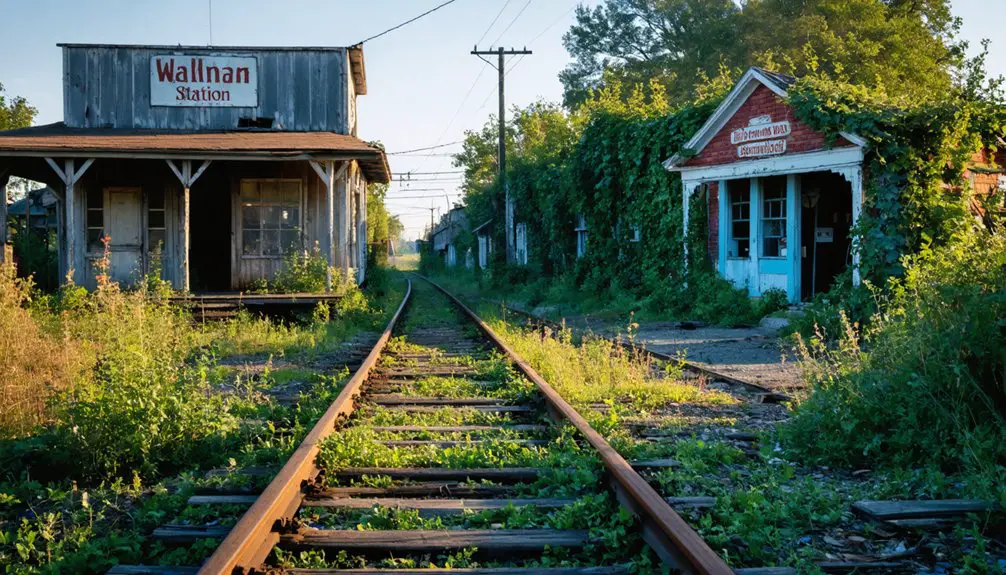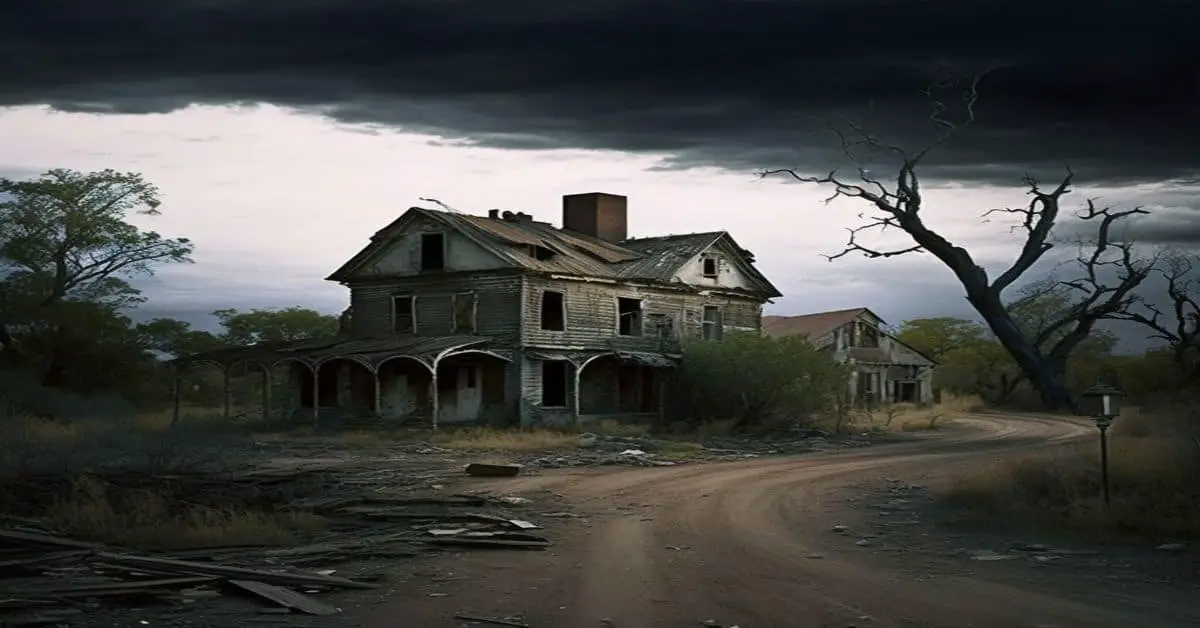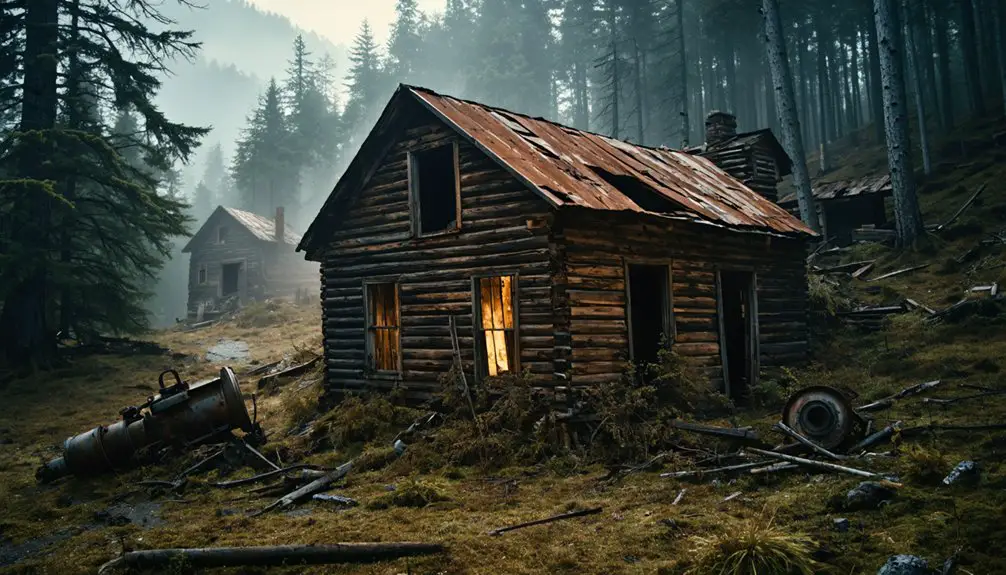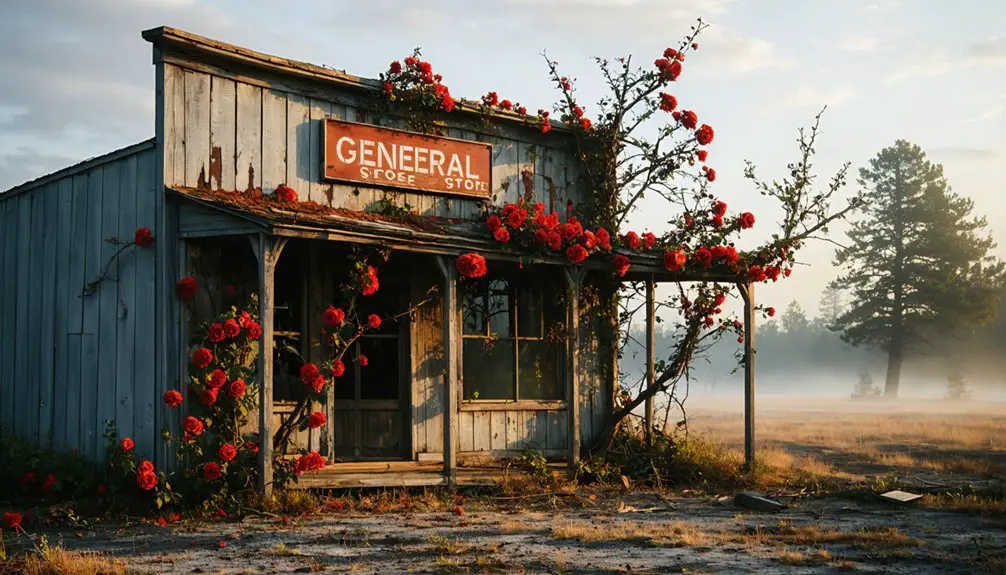You’ll find Wallman’s abandoned remains in Western Maryland’s Appalachian region, where this former coal mining town thrived from the late 1800s until its decline in the early 1900s. The town’s economy centered around the Western Maryland Railway and local mines, with workers earning about 60 cents per ton of coal. Today, you can explore the scattered ruins, including a roofless gothic church and weathered cemetery, while nature slowly reclaims what was once a bustling industrial community. The site’s untold stories await in its crumbling foundations and rusted remnants.
Key Takeaways
- Wallman was a Western Maryland coal mining town that declined after a 1906 tunnel explosion led to business failures and mass exodus.
- The abandoned town features a roofless gothic church, weathered cemetery, and scattered remnants of its coal mining past.
- Residents relied on company scrip and store purchases, creating economic dependency that made it difficult to leave during hard times.
- The Western Maryland Railway’s decreased service isolated the town, contributing to its eventual abandonment as residents sought urban opportunities.
- The site now serves as an unpreserved historical landmark, with building foundations and artifacts hidden among overgrown vegetation.
The Rise of a Coal Mining Community
As Western Maryland’s industrial appetite grew in the late 18th century, coal mining emerged as an essential economic force in the Wallman area.
You’ll find the region’s transformation began with the discovery of the “Big Vein,” a rich seam of bituminous coal that powered steamboats, locomotives, and various industries. The 1837 establishment of Lonaconing Iron Furnace marked a significant milestone as America’s first facility to use bituminous coal for pig iron production. The furnace was remarkably efficient, producing 75 tons of iron each week during its peak operations.
The area’s community growth exploded as European immigrants, primarily from Scotland, Wales, England, Ireland, and Germany, arrived to work the mines. These miners could earn a respectable living, with records showing they made about 60 cents per ton of coal extracted.
Waves of European workers, from Scottish miners to German laborers, flocked to Western Maryland’s mines, forever reshaping the region’s cultural landscape.
You’d have seen Wallman transform from a quiet settlement into a bustling mining town, complete with new railroads, stores, and businesses to support the booming coal economy that employed hundreds of workers.
Life in the Company Town
You’d find life in Wallman revolved entirely around the coal company’s control, from the scrip-based wages you earned underground to your family’s purchases at the company store.
If you were like most mining families, you’d live in a company-built house, possibly sharing close quarters with other workers in boarding arrangements during the early years before family housing became more common.
Your daily routine would be shaped by the mine whistle’s schedule, with your social life centered around company-sanctioned activities and facilities, from the church to the schoolhouse. The baseball and recreation were cherished community pastimes, mirroring the beloved baseball tradition found in nearby towns like Shallmar.
Many workers kept their union membership secret, fearing retaliation from company management if their organizing activities were discovered.
Daily Work and Pay
Working in Wallman’s coal mines meant grueling 10 to 12-hour shifts, six days a week, with miners enduring physically demanding labor that included drilling, hauling, and tunnel timbering.
The harsh work conditions took their toll, as poor ventilation, cave-ins, and coal dust exposure led to frequent accidents and health issues. Much like the historic Portal 31 tour site demonstrates today, these dangerous underground working conditions were a grim reality for coal miners.
You’d receive your weekly paycheck, often in company scrip, forcing you to spend it at the overpriced company store.
Your wages barely covered basic needs, and any economic downturn could trigger pay cuts that sparked wage disputes. The town’s lack of competition meant workers had no alternative shopping options outside the company’s control.
If you needed supplies on credit, you’d fall deeper into debt to the company.
Even children weren’t spared, as they’d work lighter jobs around the mines or stores, contributing to the family’s meager income.
Mining Family Community Life
Life in Wallman revolved entirely around the mining company’s control, from the simple wood-frame houses you’d rent to the town services your family depended on. You’d buy necessities at the company store, send your children to company-run schools, and rely on company-provided medical care.
Despite this tight corporate grip, you’d find strength in your diverse community. Your immigrant neighbors from Scotland, Wales, England, Ireland, and Germany brought rich family traditions that flourished in social clubs and ethnic churches. Coal transport by flatboats on rivers shaped early commerce before railroads arrived.
While men worked the mines, women managed households and often earned extra income through home-based work. Your children would help with chores or take paid jobs to support the family.
Through economic uncertainties and labor struggles, community resilience emerged from shared experiences and mutual support among mining families.
Company Store Economics
While mining wages appeared competitive on paper, the economic reality of Wallman’s company store system told a different story.
You’d find yourself trapped in a cycle of company store exploitation, where inflated prices for basic necessities consumed most of your earnings. The company paid you in scrip – currency that was only valid at their store – creating an inescapable economic dependency.
You couldn’t shop elsewhere, even if nearby stores offered better prices. The company store marked up everything from food to work tools, often charging double the market rate.
If you couldn’t afford essentials, you’d have to buy on credit, sinking deeper into debt with each pay period. This calculated system kept you bound to Wallman, as your growing store debt made it nearly impossible to leave for better opportunities elsewhere. By the peak year of 1907, Maryland’s coal industry was producing over 5 million tons while keeping miners trapped in this exploitative system.
Western Maryland Railway’s Role
The Western Maryland Railway served as the lifeline for Wallman by establishing essential rail access routes through challenging Appalachian terrain.
You’d find both freight and passenger services operating via flag stops, allowing residents to board or disembark on request despite the town’s remote location.
The railway’s most significant function was facilitating coal transport, connecting Wallman’s mines to broader markets and sustaining the town’s economic viability through efficient bulk shipping capabilities. Local miners faced dangerous conditions similar to those at the Falls Road intersection where tragic accidents occurred. Navigating Laurel Run Road proved challenging when accessing the old mining areas.
Railway Access Routes
Operating as a crucial transportation artery through Maryland’s challenging terrain, Western Maryland Railway established significant regional connections through its network of strategic junctions at Hagerstown, Ridgeley, and Connellsville.
You’ll find this railway expansion created essential links between coal regions and markets, with Jamison Yard at Hagerstown handling up to 3,000 westbound cars and Knobmount Yard near Ridgeley managing 1,600 eastbound cars.
The railroad’s freight logistics became even more significant through the Alphabet Route, formed by partnerships with the Pittsburgh & West Virginia Railway and other carriers.
These connections offered competitive alternatives to industry giants like B&O and Pennsylvania Railroad, while traversing the region’s demanding topography through engineered tunnels, bridges, and mountain cuts.
Vital Coal Transport Link
Building on its extensive railway network, Western Maryland Railway emerged as a powerhouse in coal transportation, establishing five major operational zones across the Appalachian region.
You’ll find WM’s transportation efficiency maximized through strategic connections, including the Thomas Subdivision that consolidated coal from Bayard and Georges Creek mines.
The railway’s coal logistics mastery showed in its ability to tackle challenging 3% grades using pusher locomotives, especially on the Black Fork Grade near Elkins.
Through the Alphabet Route network, WM delivered coal to steel centers in Baltimore, Allentown, and Pittsburgh.
The railway’s integration with B&O and C&O connections expanded its reach, while facilities like Knobmount Yard near Cumberland enabled precise weighing and sorting of coal shipments.
Economic Decline and Abandonment
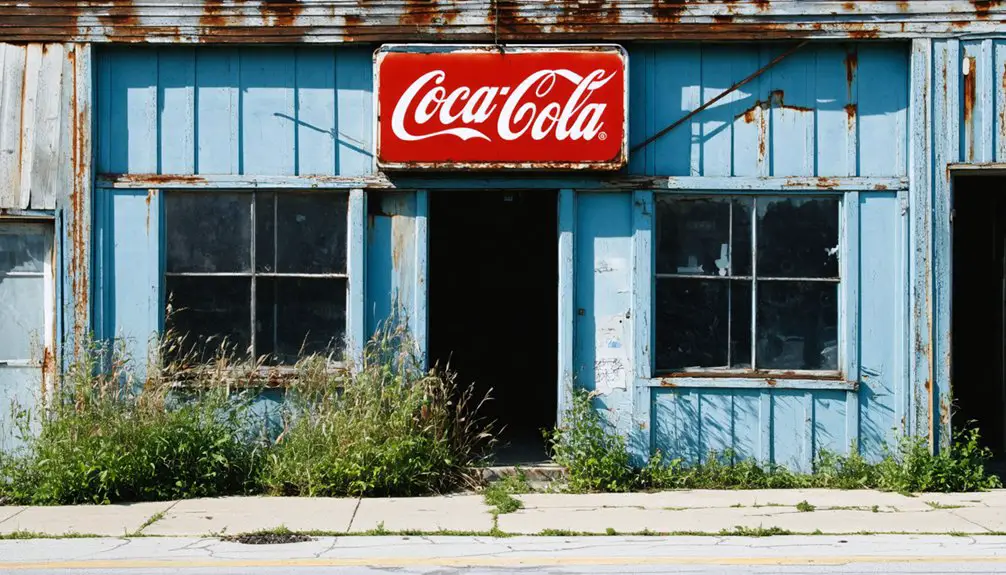
During the early 1900s, Wallman’s economic stability crumbled as its coal-dependent economy faced mounting challenges. The economic impact of mine closures, including the devastating 1906 tunnel explosion, triggered a chain reaction of business failures and job losses.
This community transformation was intensified by the town’s reliance on mining company scrip, which limited residents’ purchasing power to company stores.
- Mine safety incidents and reduced coal demand led to widespread mine closures
- Western Maryland Railway’s decreased service isolated the town from trade opportunities
- Limited road access prevented industrial diversification beyond coal mining
- The scrip-based economy collapsed when mining operations failed
You’ll find that Wallman’s residents gradually abandoned their homes, seeking better prospects in urban centers with modern infrastructure and diverse job opportunities.
Exploring the Ghost Town Today
As you venture into Wallman’s abandoned grounds today, you’ll find a haunting memorial to Maryland’s industrial past nestled within Garrett County’s rugged terrain.
Urban exploration here requires careful preparation – bring your GPS, topographic maps, and sturdy hiking boots to navigate the overgrown landscape.
Pack essential navigation tools and rugged footwear before exploring this wild, challenging terrain where remnants of industry meet untamed nature.
You’ll need to proceed on foot through the site, where nature has steadily reclaimed former streets and building foundations.
While photographing decaying structures and historical remnants, stay alert for unstable ground and weakened buildings.
No formal historical preservation efforts exist, so you’re witnessing the site in its raw, untamed state.
Remember to research the location’s history beforehand, as you won’t find interpretive signage on-site.
Check local regulations, as some areas may be private property.
Remnants and Ruins
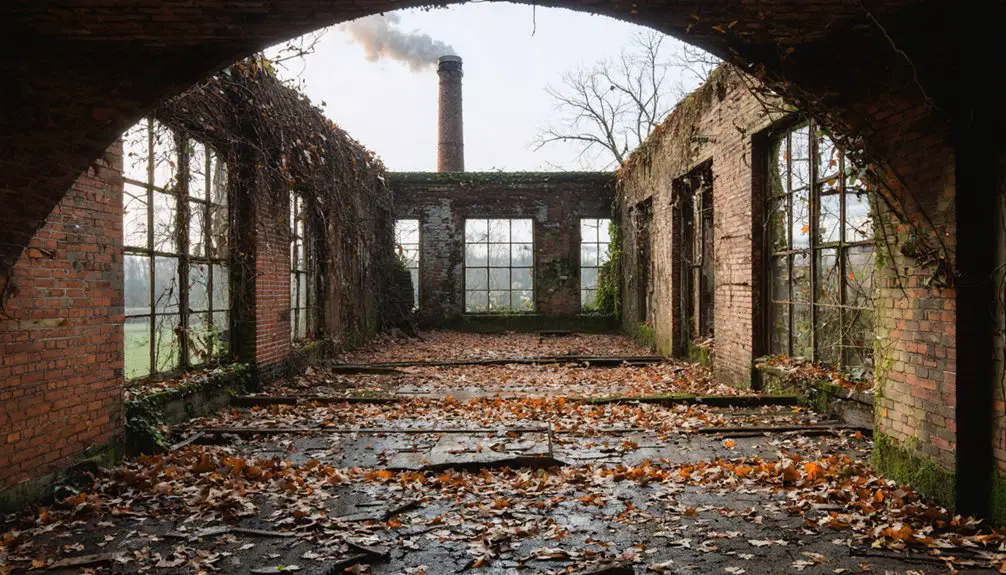
Remnants of a once-thriving community lie scattered across Wallman’s ghostly landscape, with most original structures having succumbed to destruction since the town’s abandonment.
During your ruins exploration, you’ll encounter the haunting remains of a roofless gothic church and its weathered cemetery, where toppled gravestones tell stories of former residents like James William Hickey. Tropical Storm Agnes‘s devastating impact in 1972 erased most structures, leaving nature to reclaim what’s left.
- Pre-1972 vehicles and farm equipment rust among the overgrowth
- Historical artifacts from daily life remain dispersed across the site
- The church ruins stand as the primary architectural remnant
- An untamed cemetery holds secrets behind the church
Today, these remnants serve as silent witnesses to Wallman’s past, though preservation efforts have largely failed to protect them.
Surrounding Coal Communities
While Wallman’s decline left it largely abandoned, the surrounding George’s Creek Basin once bustled with nearly 500 coal mines across Western Maryland’s rugged landscape.
You’ll find the remnants of vibrant mining towns that stretched from Bloomington to Kempton and from Westernport to Oakland, straddling both sides of the Potomac River.
The community dynamics reflected a rich tapestry of life, powered by an immigrant workforce from Scotland, Wales, England, Ireland, and Germany.
Immigrants from across Europe wove their cultural threads into the vibrant fabric of these mining communities.
These coal communities supported diverse neighborhoods with thriving businesses, where miners worked about 250 days yearly during the industry’s peak.
The coveted “Big Vein” bituminous coal drew workers and industry alike, transforming the valley into a powerhouse of economic activity until the devastating decline of the 1930s.
Historical Significance in Garrett County
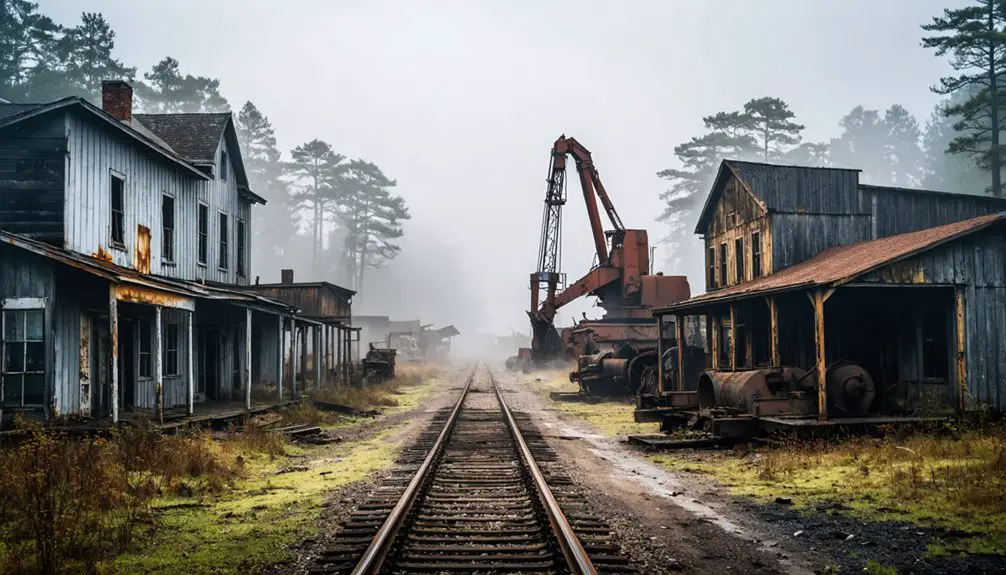
The ghost town of Wallman stands as a tribute to Garrett County’s pivotal role in Maryland’s coal industry during the late 19th and early 20th centuries.
You’ll find this abandoned community’s cultural heritage deeply woven into the region’s industrial past, where mining technology and transportation networks shaped the landscape along the upper Potomac River.
- The town’s strategic location near rail lines and the Potomac River made it a key player in Maryland’s coal production.
- Wallman’s mines helped power regional industrialization, supporting railroad operations and iron manufacturing.
- Archaeological remains and structural foundations provide valuable insights into early mining practices and community life.
- The site serves as a powerful reminder of how resource-dependent communities faced economic changes in Appalachia.
Preserving Wallman’s Legacy
Modern preservation efforts bring Wallman’s rich history into focus through innovative documentation and community engagement initiatives.
You’ll find that despite the absence of original structures, cement foundations and abandoned railroad beds serve as tangible links to this vanished mining community. Preservation challenges include physical decay and vegetation overtaking the site, but digital reconstruction methods and interpretive signage help tell Wallman’s story.
Through community stewardship programs, you can participate in educational workshops and heritage trails that connect you to the town’s past.
Organizations like Preservation Maryland support these efforts while promoting sustainable practices and material reuse. Collaboration with indigenous groups, archaeologists, and former residents guarantees that Wallman’s cultural significance endures through oral histories, artifacts, and museum collections.
Frequently Asked Questions
Were There Any Notable Accidents or Disasters in Wallman’s Mining Operations?
You’ll find mining hazards were common, but specific accident reports from Wallman’s operations aren’t documented. Nearby western Maryland coal mines experienced several deadly explosions and cave-ins in the early 1900s.
What Was the Peak Population of Wallman During Its Most Prosperous Years?
Precise population patterns prove perplexing, as you’ll find no definitive demographic trends recorded during Wallman’s mining boom. Based on similar Maryland ghost towns, it likely peaked at several hundred residents.
Did Any Famous People or Historical Figures Ever Visit Wallman?
You won’t find records of any famous visitors to this location. While the area held historical significance for coal mining, there’s no documentation of notable figures ever stopping by.
What Native American Tribes Originally Inhabited the Wallman Area Before Settlement?
While you’ll find both Iroquoian Susquehannocks in Maryland’s interior, the Wallman area’s Native tribes were primarily Algonquian-speaking peoples, including the Nanticoke, Assateague, and Pocomoke, who thrived along coastal waterways.
Are There Any Documented Paranormal Activities or Ghost Stories From Wallman?
You won’t find documented ghost sightings or haunted locations in Wallman. While nearby Maryland coal towns have supernatural folklore, there’s no credible evidence of paranormal activity specific to this remote ghost town.
References
- http://www.mountaindiscoveries.com/stories/fw2002/heritagetrail_plain.html
- https://rsftripreporter.net/ghost-towns-of-the-upper-potomac/
- https://www.youtube.com/watch?v=nJzauuAFgr0
- https://en.wikipedia-on-ipfs.org/wiki/List_of_ghost_towns_in_Maryland
- https://kids.kiddle.co/List_of_ghost_towns_in_Maryland
- http://www.mountaindiscoveries.com/images/fw2018/stories/Underground Coal Mining.pdf
- https://www.whilbr.org/GeorgesCreek
- https://www.mdmountainside.com/blog/post/coal-heritage-itinerary/
- https://wildful.wordpress.com/2018/05/16/34-the-legacy-of-coal-in-western-md-part-one/
- https://wildful.wordpress.com/2018/05/16/35-coal-in-western-md-part-two-whatever-happened-to-the-coal-towns-guest-jim-rada/
